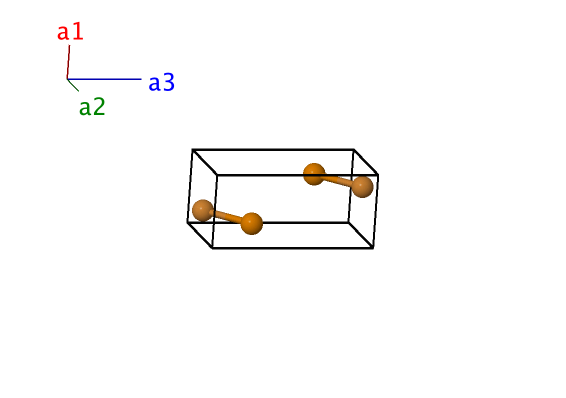
Vulcanite (CuTe) Structure: AB_oP4_59_a_b
| Prototype | : | CuTe |
| AFLOW prototype label | : | AB_oP4_59_a_b |
| Strukturbericht designation | : | None |
| Pearson symbol | : | oP4 |
| Space group number | : | 59 |
| Space group symbol | : | $\mbox{Pmmn}$ |
| AFLOW prototype command | : | aflow --proto=AB_oP4_59_a_b --params=$a,b/a,c/a,z_{1},z_{2}$ |
Simple Orthorhombic primitive vectors:
\[
\begin{array}{ccc}
\mathbf{a}_1 & = & a \, \mathbf{\hat{x}} \\
\mathbf{a}_2 & = & b \, \mathbf{\hat{y}} \\
\mathbf{a}_3 & = & c \, \mathbf{\hat{z}}
\end{array}
\]
Basis vectors:
\[ \begin{array}{ccccccc} & & \mbox{Lattice Coordinates} & & \mbox{Cartesian Coordinates} &\mbox{Wyckoff Position} & \mbox{Atom Type} \\ \mathbf{B}_{1} & =&\frac14 \, \mathbf{a}_{1}+ \frac14 \, \mathbf{a}_{2}+ z_{1} \, \mathbf{a}_{3}& =&\frac14 \, a \, \mathbf{\hat{x}}+ \frac14 \, b \, \mathbf{\hat{y}}+ z_{1} \, c \, \mathbf{\hat{z}}& \left(2a\right) & \mbox{Cu} \\ \mathbf{B}_{2} & =&\frac34 \, \mathbf{a}_{1}+ \frac34 \, \mathbf{a}_{2}- z_{1} \, \mathbf{a}_{3}& =&\frac34 \, a \, \mathbf{\hat{x}}+ \frac34 \, b \, \mathbf{\hat{y}}- z_{1} \, c \, \mathbf{\hat{z}}& \left(2a\right) & \mbox{Cu} \\ \mathbf{B}_{3} & =&\frac14 \, \mathbf{a}_{1}+ \frac34 \, \mathbf{a}_{2}+ z_{2} \, \mathbf{a}_{3}& =&\frac14 \, a \, \mathbf{\hat{x}}+ \frac34 \, b \, \mathbf{\hat{y}}+ z_{2} \, c \, \mathbf{\hat{z}}& \left(2b\right) & \mbox{Te} \\ \mathbf{B}_{4} & =&\frac34 \, \mathbf{a}_{1}+ \frac14 \, \mathbf{a}_{2}- z_{2} \, \mathbf{a}_{3}& =&\frac34 \, a \, \mathbf{\hat{x}}+ \frac14 \, b \, \mathbf{\hat{y}}- z_{2} \, c \, \mathbf{\hat{z}}& \left(2b\right) & \mbox{Te} \\ \end{array} \]References
- E. N. Cameron and I. M. Threadgold, Vulcanite, a new copper telluride from Colorado, with notes on certain associated minerals, Am. Mineral. 46, 258–268 (1961).
Found in
- R. T. Downs and M. Hall–Wallace, The American Mineralogist Crystal Structure Database, Am. Mineral. 88, 247–250 (2003).
